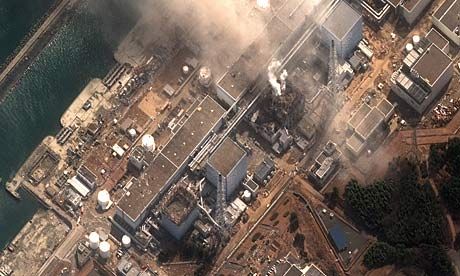
Non-essential technicians were evacuated from the facility after radiation levels around the Fukushima No 1 power plant briefly rose four-fold in the wake of the blast, which appears to be the most serious to date.
The plant operators said its reading had reached 8,217 microsieverts per hour - described by broadcaster NHK as equivalent to eight times the radiation a person would usually experience in a year. It later fell sharply, the broadcaster said. The peak was still far below the level which would cause immediate damage to health.
Fifty workers remained at the plant, battling to cool three reactor cores after the blast at around 6.10am Japanese time. The Tokyo Electric Power Company has admitted for the first time that partial meltdown could be underway - as officials had previously suggested - Kyodo news agency said.
Kyodo reported there had been damage to the suppression pool of the containment vessel - increasing the risk of a significant release of radioactive material.
It came as the official death toll from the worst earthquake and tsunami in Japan's recorded history reached almost 2,800, with tens of thousands still unaccounted for. Millions of survivors woke up to a fifth day in the disaster zone with dwindling supplies of food and fuel, following another 24 hours of aftershocks, blazes and tsunami alerts.
Earlier officials had admitted the reactor could be in partial meltdown and warned the situation was "even worse" than in the other two units with cooling problems.
"Although we cannot directly check it, it's highly likely happening," Yukio Edano, the chief government spokesman, told reporters. On Monday a second hydrogen explosion had blown the walls off another reactor unit.
With confidence diminishing in the Tokyo Electric Power Company's ability to handle the crisis, prime minister Naoto Kan said he would personally lead a new joint response headquarters based at the firm's headquarters.
As Tokyo struggled to handle the spiralling crisis it asked both the United Nations nuclear watchdog for expert help and the US nuclear regulatory commission for equipment. Officials also began to distribute potassium iodide, which can help inhibit the uptake of radioactive iodide by the thyroid, to evacuation centres. They have already evacuated hundreds of thousands of residents within a 12-mile radius of the facility.
But Yukiya Amano, director general of the International Atomic Energy Agency, stressed that it was "unlikely that the accident would develop" like Chernobyl, and said the reactor vessels remained intact. Officials in Japan had earlier suggested one might have been breached.
Several countries announced they would screen Japanese produce for radiation as a precaution. US officials said military personnel taking part in rescue efforts registered low levels of radioactive contamination after flying by helicopter back to their ships off the Japanese coast. They were cleared after a scrub-down but the ships moved position as a precaution.
The desperate shortage of supplies was a more immediate concern for the millions facing a fourth night in near-freezing temperatures. NHK reported that many emergency shelters were running out of food and fuel, leaving weakened survivors cold and hungry.
"People are surviving on little food and water. Things are simply not coming," Hajime Sato, a government official in Iwate, told Associated Press. He said the prefecture was receiving just a tenth of the food and supplies it needed. "We just did not expect such a thing to happen. It's just overwhelming," he said.
With aftershocks of up to magnitude 6.1 continuing, survivors fled to high ground in the morning as sirens blared and broadcasters announced a tsunami alert. It later proved to be a false alarm.
But Friday's 9.0-magnitude quake and tsunami have already left around 1,000 bodies on shores of the Oshika Peninsula and another 1,000 bodies in Minamisanriku, according to officials and police in Miyagi province. Around 9,500 people remain uncontactable in the latter town. The Kyodo news agency also said police and firefighters were still trying to recover 200 to 300 bodies in Sendai.
In Iwate prefecture, around 8,000 inhabitants are missing from one small town, Otsuchi. Thousands were also missing in Soma, a city of 38,000 people, according to officials.
On Monday, David Cameron told MPs there were "severe concerns" about the safety of several British nationals in Japan, but no confirmed fatalities.
In a statement to the Commons, the prime minister said the devastation in Japan was of "truly colossal proportions".
The country's ailing economy, overtaken by China as the world's second largest last year, is also struggling with the impact of the disaster. The central bank injected 15tr yen (£113bn) into money markets to stabilise the situation. But the benchmark Nikkei 225 stock average slid 6.2%.



Reader Comments
to our Newsletter